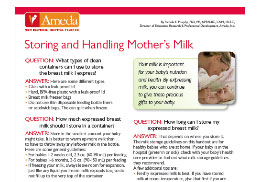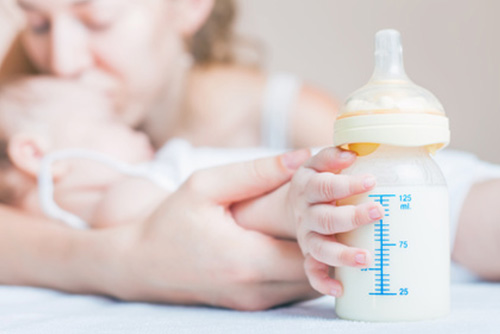Guidelines
- Freshly pumped milk is best. If you have stored milk at room temperature and are going to miss a breastfeeding session with your baby, give the milk stored at room temperature first.
- When in doubt about the freshness of your milk, smell or taste it. Spoiled milk will usually smell spoiled.
- If you plan to use your milk within 8 days, it can be kept in the refrigerator. If not, plan to freeze it in the coldest part of the freezer. Avoid storing your milk in the door.
- Before freezing large amounts of milk, freeze 1-2 batches then thaw and smell it. Some mothers make milk high in lipase, an enzyme that digests fat; when thawed the milk high in lipase has a strong, soapy smell.
- If you find your breast milk is in high lipase, you can scald the milk before freezing to deactivate it. (To scald your milk, heat in a pot on the stove top until bubbles form at the edges, then cool and freeze.)
- If you follow the recommendations on the chart below, you can keep your milk at room temperature, refrigerate it, then freeze it.
Storage Time for Human Milk*
Research confirms that your milk will not spoil before the times listed in this table, but the longer your milk is stored, the more vitamins and antioxidants that are lost. That’s why some breastfeeding books list shorter storage times. Experts prefer you to use your milk sooner rather than later, but this doesn’t mean that your milk will spoil if you wait longer.

*Storage times may vary for preterm or sick babies. Sources: Jones, F. , Best Practice for Expressing, Storing and Handling Human Milk in Hospitals, Homes and Child Care Settings. Raleigh, NC: Human Milk Banking Association of North America, 2011; Mohrbacher, N. Breastfeeding Answers Made Simple: A Guide for Helping Mothers. Amarillo, TX: Hale Publishing, 2010.
Breast Milk Containers
- Glass or hard plastic BPA free containers with leak-proof lids can be used
- Breast milk freezer bags are also an option
- Avoid sandwich bags or thin disposable feeding bottle liners- these types of liners are meant to be used as bottle feeding bags, not for freezing breast milk
How Much to Store Per Container
- Store your milk in the smallest amount possible that your baby might take. You can always add more milk to the bottle during a feeding if your baby wants more, but don’t save the leftover milk once the bottle has been in your baby’s mouth.
- If you are freezing your milk, always leave room for expansion. Just like any liquid you freeze, milk expands when frozen.
- You can combine milk pumped at different times.
- Chill freshly expressed milk before adding to already frozen milk, when combining milk from different days be sure to write the date of the oldest milk on the container.
Labeling Breast Milk for Storage
- Write the date and time on your milk container using a sticky label or non-toxic marker. It’s a good idea to add your baby’s name if your baby is at a facility that cares for other babies or toddlers.
- When storing milk from different days together, write the date of the oldest milk on the label.
Preparing Stored Milk For Baby
- An older, larger baby can handle drinking chilled milk, but milk needs to be warm for a tiny baby. If a newborn is fed cold milk, it can bring down his body temperature. For a younger baby, warm your milk to between room and body temperature.
- Whether warming chilled milk or thawing frozen milk, keep the heat low. High heat kills the live cells in your milk that help keep your baby healthy.
- Warm your milk to between room and body temperature under cool then warm running water. Keep warm water away from the bottle lid so that it doesn’t mix with the milk.
- One way to do this is to put a bottle in a bowl with the sides lower than the bottle’s lid. Run warm water in the bowl. The warm water against the sides of the bottle warms the milk.
- You can thaw frozen milk in the refrigerator. Use this milk within 24 hours.
- Your milk is not homogenized like the milk in the store, so it may separate into layers and the cream may rise to the top. If this happens, just gently swirl it to mix
- Don’t warm milk in the microwave, it changes the milk and causes hot spots that can burn your baby’s mouth and throat.
- Don’t heat the milk in a pot on the stove, high heat can make the milk too hot for your baby and it destroys the antibodies your baby needs.
Having support from your partner can help you be more successful throughout your breastfeeding journey. Learn how important Dad’s role is to your success.
This is general information and does not replace the advice of your healthcare provider. If you have a problem you cannot solve quickly, seek help right away. Every baby is different. If in doubt, contact your physician or healthcare provider.
Get My Insurance Covered Pump
Complete our online form and we'll take care of the rest!


